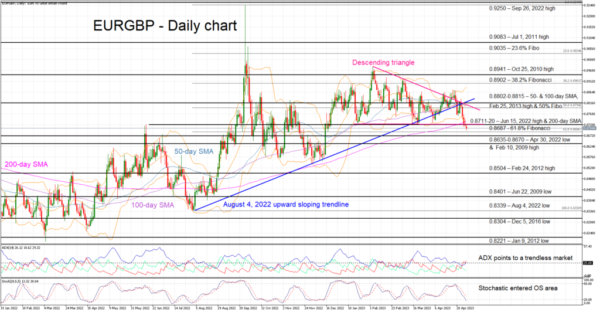Events elsewhere have been stealing the headlines lately, but this week’s focus will almost entirely be on the UK as the BoE is holding its rate setting meeting on Thursday. Will the BoE decision provide another boost to the pound against the euro?
BoE’s inflation problem
Banking sector shenanigans in the US, the much-talked Chinese reopening and euro area developments have recently monopolized the market’s interest. But this week the BoE will be in the spotlight. This is the third meeting for 2023 and comes a week after the crucial Fed and ECB meetings. The market is pricing in a very strong probability of a 25bps move. Interestingly, the market is expecting a total of 65 bps of rate hikes (including Thursday’s move) until the November 2, 2023 meeting, contrary to the rate cuts expectations for the Fed.
We understand the reasons behind these market expectations, but we are not confident that the BoE members have taken seriously enough the inflation ravaging the UK economy. It remains the only developed economy with double digit inflation – the March CPI printed at 10.1% year-on-year change – but their rhetoric is less hawkish when compared to other top central banks that face lessened inflationary pressures.
We have commented in the past that the BoE was kind of hoping that a recession in the US would cause a slowdown in the UK and hence push inflation lower aggressively. This has not taken place, up to now, as the US economy continues to grow at a respectable rate.
Could the BoE hike by 50 bps?
The BoE hiked by 25 bps at the March 23 meeting following the 50 bps rate move at the February gathering. While the elevated outright inflation rate means that the BoE has to continue removing accommodation, the MPC members are expected to weigh the pros and cons of hiking rates more aggressively. From one side, the housing sector is clearly suffering from the higher rates, especially when examining the recent mortgage lending figures. On the other hand, the Services PMI figure stands at a 1-year high, and the average earnings are flirting with the 2021 highs.
Should the BoE opt for a stronger move, the focus would then turn to the Monetary Policy Statement (formerly Quarterly Inflation Report) published also on Thursday. At its February edition this Statement was forecasting 3% inflation for the fourth quarter of 2024. A stronger rate hike on Thursday would mean increased inflation projections at the famous Table 1.A.
Data calendar full
The week opened with the BRC retail sales printing stronger than expected and the Halifax House Price index returning to negative territory. On Friday and as the market digests the BoE announcement, we will get the preliminary GDP print for the first quarter of 2023 along with the March industrial and manufacturing industrial data. Following the downside surprise at the US advance GDP print, there is a growing risk for a similar outcome on Friday.
Euro/pound broke through a key area – will the breakout last?
The February high of 0.8978 seems to have energized the pound bulls as the euro/pound pair has been recording a series of lower highs. However, since the eve of 2023 their efforts for a sustainable drop have stopped at the 0.8720 area, forming a descending triangle pattern. Interestingly, the pair has just broken below this level, but it needs a push from the BoE for this move to count.
A stronger than expected rate hike or a 25 bps move accompanied with hawkish rhetoric has the potential to push the euro/pound pair towards the 0.8635 area and test the December 2022 lows. On the other hand, a confirmation of the market expectations and the usual dovish rhetoric from Bailey et al could allow the euro bulls to regain market control and aim for the 0.88 area.
















